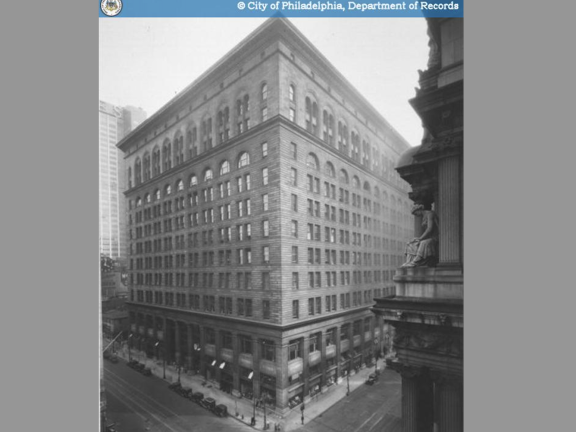Wanamaker Building

The Wanamaker Building is literally a palace of shopping. Built by John Wanamaker in 1902-1911, the department store was modeled on the town house of a Renaissance merchant, such as the Palazzo Medici in Florence, but much enlarged and with the central courtyard roofed to provide protection from American weather.
Wanamaker (1838-1922) was an innovator who helped introduce Americans to the new, French idea of the “department” store, in which goods were displayed in a clearly organized system and with clearly marked prices. He started his business in 1861, selling men’s clothing, and in 1876 he opened a much-enlarged store in the huge freight hall at 13th and Market Streets that he acquired from the Pennsylvania Railroad, whose tracks across Center Square had been cut by the construction of the new City Hall. His “Grand Depot” caught the attention of visitors to Philadelphia’s Centennial Exhibition, and the next year he reorganized it as a department store with an ever-expanding variety of merchandise—from sewing needles to grand pianos.
Wanamaker’s sustained success encouraged him to build an all-new store, for which he hired Daniel H. Burnham, the renowned Chicago architect who was Director of Works for the World’s Columbian Exhibition in Chicago in 1893. He was famous for skyscrapers—including Philadelphia’s Land Title Building (1897), but in the early twentieth century he also designed many department stores; in addition to Wanamaker’s, these included Marshall Field’s in Chicago, Filene’s in Boston, Gimbel Brothers’ in New York, and Selfridge’s in London.
Wanamaker transformed shopping into an experiential activity, emphasizing customer service, high quality, immense variety, money-back guarantees, and cultural enrichment. The Wanamaker Building embodies his ideals, with a grand central court, a top-floor restaurant (the Crystal Tea Room), and an auditorium for public events. The court features two iconic artifacts that Wanamaker encountered at the 1904 Louisiana Purchase Exposition (the St. Louis World's Fair). The sculptor August Gaul’s 2500-pound bronze Eagle was created to represent Germany in St. Louis, but, purchased by Wanamaker, it became the symbol of the store. Philadelphians say “meet me at the eagle” to rendezvous with friends.
The Wanamaker Grand Court Organ was designed by George Ashdown Audsley and built by the Los Angeles Art Organ Company for the fair, and afterwards it languished in storage until 1909, when Wanamaker acquired it for his store. The original instrument, the largest in the world and designed to be the equal of a full orchestra, had 10,059 pipes, and the colossus was enlarged to meet the ambitions of Wanamaker’s daily concerts, bringing the total to 28,750—still
the largest fully functioning pipe organ in the world.
The Wanamaker family sold what had grown to a chain of stores in 1978, and, under a succession of owners, the flagship store continued to function under other names (Lord & Taylor, Hecht’s, Strawbridge’s, and Macy’s) until 2025. The facades, interior court, and the eagle are designated Philadelphia landmarks and protected from alternation.
Official website
Address: 100 E Penn Square, Philadelphia, PA 19107